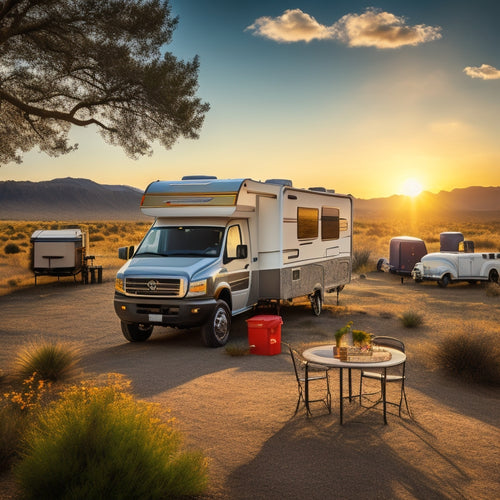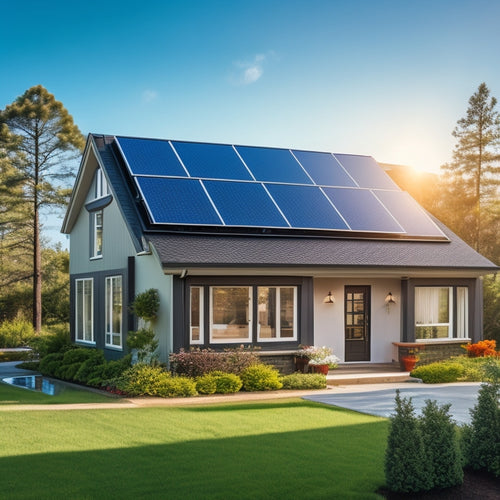
What Are Top Three Things to Know About Home Solar and Wind Power Systems
Share
When considering home solar and wind power systems, you should know that these renewable energy sources can greatly reduce your reliance on fossil fuels and lower your energy bills. You'll want to understand the cost and efficiency considerations, including the initial investment, system design, and energy conversion rates. Finally, it's crucial to analyze your property's potential, evaluating factors like sunlight, wind speed, and local regulations, which will help you make an informed decision about which system is right for you, and then you can investigate the specifics that will bring you closer to utilizing the power of renewable energy.
Key Takeaways
- Renewable energy sources like solar and wind reduce reliance on fossil fuels, providing cleaner alternatives for powering your home.
- Costs for solar and wind systems have decreased significantly, making them more accessible, with initial investment including system, installation, and maintenance costs.
- Proper installation and maintenance are crucial, requiring certified installers, secure electrical connections, and regular upkeep to ensure safe and reliable operation.
- Federal and state incentives, such as the Solar Investment Tax Credit, can significantly reduce the upfront cost of installing a home solar or wind power system.
- A site assessment is necessary to determine your property's suitability for solar or wind systems, considering factors like sunlight, wind speed, and local regulations.
Understanding Renewable Energy Sources
With the world shifting towards a more sustainable future, you're likely aware of the increasing importance of renewable energy sources. As you consider generating power for your home, you're probably wondering about the options available.
Renewable energy sources utilize natural resources to produce electricity, reducing reliance on fossil fuels and mitigating climate change. Two prominent forms of renewable energy are solar technology and wind energy.
Solar technology converts sunlight into electricity using photovoltaic (PV) panels or solar thermal systems. These systems can be installed on rooftops or in open spaces, making them a viable option for homes with sufficient sunlight.
On the other hand, wind energy employs wind currents to power turbines, generating electricity. Wind turbines can be installed on a small scale, such as in backyard installations, or on a larger scale, like wind farms.
Both solar technology and wind energy offer a cleaner, more sustainable alternative to traditional energy sources. By understanding these renewable energy sources, you can make informed decisions about which option is best suited for your home and contribute to a more environmentally friendly future.
Cost and Efficiency Considerations
As you evaluate the benefits of solar and wind power, you're likely thinking about the cost and efficiency of these systems. The cost of solar and wind power systems has decreased notably over the years, making them more accessible to homeowners. However, the initial investment can still be substantial.
You'll need to take into account the cost of the system itself, as well as installation, maintenance, and any necessary upgrades to your electrical infrastructure.
When it comes to efficiency, solar and wind power systems have made remarkable progress. Solar panels can convert up to 22% of sunlight into electricity, while wind turbines can achieve efficiency rates of up to 50%.
To optimize efficiency, it's crucial to take into account factors like system size, battery storage, and grid integration. By storing excess energy generated during the day in batteries, you can reduce your reliance on the grid and maximize your energy independence.
Additionally, integrating your system with the grid allows you to sell excess energy back to the utility company and offset your energy costs. By carefully evaluating these factors, you can create a cost-effective and efficient home solar or wind power system that meets your energy needs.
Installation and Maintenance Needs
You've optimized your solar or wind power system for efficiency, now it's time to evaluate the installation and maintenance needs that will guarantee your system operates smoothly over its lifetime. A proper installation is vital to guarantee your system operates at its maximum potential. It's important to hire a certified installer who can design a system that meets your energy needs and complies with local building codes.
| Installation Consideration | Why It Matters |
|---|---|
| System design | A well-designed system guarantees peak energy production and reduces maintenance needs. |
| Energy storage installation | Proper installation of energy storage systems, like batteries, guarantees safe and efficient operation. |
| Electrical connections | Secure electrical connections prevent safety hazards and guarantee reliable energy transmission. |
| Mounting and tracking systems | Proper mounting and tracking systems guarantee your solar panels or wind turbines are securely fastened and optimized for energy production. |
| Grounding and bonding | Proper grounding and bonding guarantee your system meets safety standards and reduces the risk of electrical shock. |
Incentives and Policy Support
Governments and utilities offer various incentives to encourage the adoption of home solar and wind power systems, recognizing their crucial role in reducing our reliance on fossil fuels and mitigating climate change.
As you consider investing in a renewable energy system, understanding these incentives can help you make a more informed decision.
You're likely eligible for federal incentives, such as the Solar Investment Tax Credit (ITC), which allows you to claim a tax credit of up to 26% of the total cost of your solar or wind power system.
Additionally, many states have their own policies and incentives, such as net metering laws, which enable you to sell excess energy back to the grid and offset your electricity costs.
State policies can vary widely, so it's important to research the specific incentives available in your area.
Evaluating Your Property's Potential
Frequently, homeowners overlook an essential step in the process of installing a home solar or wind power system: evaluating their property's potential. This vital step determines whether your property is suitable for a solar or wind power system and what size of system you'll need. A site assessment and energy audit are vital in evaluating your property's potential.
| Factor | Consideration |
|---|---|
| Sunlight | Amount of shading, orientation, and slope of your roof |
| Wind | Speed, direction, and turbulence around your property |
| Energy usage | Your current energy consumption and patterns |
| Roof size and condition | Space available for solar panels and roof's structural integrity |
| Local regulations | Zoning laws, permits, and neighborhood covenants |
Frequently Asked Questions
Can I Install Solar Panels on a Metal Roof?
You can install solar panels on a metal roof, leveraging the metal roof advantages of durability and weather-tightness, while also reaping solar panel benefits like energy independence and reduced carbon footprint.
Will Wind Turbines Interfere With Wi-Fi Signals?
You're wondering if wind turbines will disrupt your Wi-Fi signals. Research shows that wind turbine interference is unlikely to cause significant signal disruption, as turbines typically operate at frequencies far below Wi-Fi's 2.4 GHz range, minimizing potential interference.
Can I Use a Generator as a Backup Power Source?
You can use a generator as a backup power source, but you'll need to prioritize generator maintenance to guarantee reliability, and consider generator efficiency to minimize fuel consumption and environmental impact.
Are Solar Panels Damaged by Hail or Heavy Snow?
You're wondering if a hailstorm of biblical proportions or a snowfall of epic magnitude will destroy your solar panels? Relax, most panels are engineered to withstand hail damage up to 1-inch diameter and snow accumulation of 50 pounds per square foot!
Can I Install a Hybrid Solar-Wind Power System?
You can install a hybrid solar-wind power system, combining both energy sources to optimize your renewable energy output. Make certain you meet installation requirements, including sufficient space, compatible components, and local permits, to successfully integrate hybrid energy into your home.
Conclusion
As you weigh the benefits of home solar and wind power systems, remember that utilizing renewable energy can greatly reduce your carbon footprint and energy bills. Research suggests that households that invest in these systems can break even on their investment in as little as five to seven years. By understanding the cost and efficiency considerations, installation and maintenance needs, and incentives, you'll be well on your way to accessing the power of nature and saving money in the long run.
Related Posts
-

What You Need to Know About RV Solar Maintenance
When you're out on the road, your RV's solar panel system is your lifeline. But without regular maintenance, you're l...
-

Planning for an Electric Vehicle-Friendly Urban Future
As you plan for an electric vehicle-friendly urban future, you'll need to integrate high-power charging stations, sma...
-

Solar Power Units Perfect for Homes
You're considering installing a solar power unit in your home, a decision that can notably reduce your reliance on tr...


